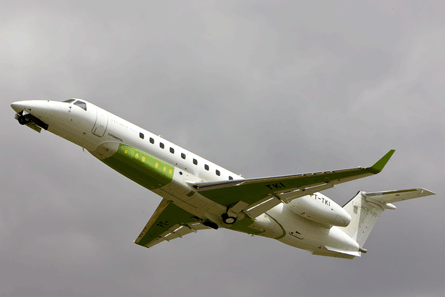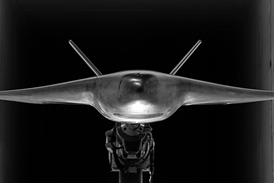Embraer has revealed that it has successfully flown the first Legacy 650 large-cabin business jet, an upgraded version of its super-midsize Legacy 600. The launch brings to seven the total number of executive jets in the Brazilian airframer's portfolio.
"One thing our Legacy customers kept telling us is that the aircraft should have more range," says Claudio Camelier, Embraer's vice-president of market intelligence for executive jets. "The 650 is a response to that demand."
Embraer began delivering the Legacy 600, a derivative of the ERJ-135 regional jet, in 2002 and has produced more than 170 to date. Embraer considers the Legacy 600 to be a super-midsize category aircraft and the new 650 a large-cabin offering.
The company has two 650s flying in Brazil, one prototype and one pre-series version that flew within days of each other for the first time in late September, says Camelier. The flight test programme is scheduled for completion by mid-2010, with certification and service entry expected in the second half of 2010. The company launched the programme internally in first half of 2008, says Camelier.
 |
|---|
© Embraer |
To boost range, Embraer installed a new underbelly ventral fuel tank and created more fuel storage in the central wing box, increasing total fuel load by 1,160kg (2,558lb) to 9,402kg. The fuel system has been redesigned with electrically actuated valves from hydraulically actuated valves on the 600.
Combined with airframe modifications and new Rolls-Royce AE3007-A2 turbofan engines, upgrades of the Legacy 600's AE3007-A1E engines, the Legacy 600 will deliver 7,220km (3,900nm) range, an increase of 925km, based on four 91kg (200lb) passengers NBAA IFR reserves (370km alternate airport and 35min of holding at 5,000ft/1,525m). The capability will for the first time allow non-stop legs such as São Paulo to Miami, London to New York and Moscow to Shanghai, says Embraer. Trading range for payload, the 650 can carry an additional 1,134kg compared with the 600 for a 6,290km trip.
On the ramp, the $29.5 million Legacy 650 (2010 dollars) will be largely indistinguishable from its $27.45 million sister aircraft.
Visible changes include a slightly lower aircraft height of 6.64m for the 650 versus 6.67m for the 600, a change related to its increased maximum ramp weight of 22,570kg, up 1,800kg from the Legacy 600.
Also apparent are modifications to the aft section of the wing-fuselage fairing and a reduction of two blades on each engine fan, down from 24 blades on each AE3007-A1E. The redesigned fan blade produces 9,020lb (40kN) maximum take-off thrust, up 10% from the A1E, resulting in the same take-off performance as the 600 at maximum take-off weight or better rate-of-climb performance at lower weights.
In the cabin, changes include a new noise reduction package and Swift broadband high-speed internet.
Not visible is a stronger new wing that comes directly from the ERJ-145XR regional airliner that allows for an increased maximum flap (45e_SDgr) extension speed to 160kt (295km/h) from 145kt.
A new Herculite II glass windshield, compared with the polycarbonate polymer transparencies for the 600, boosts the maximum operating speed below 8,000ft from 250kt to 300kt. The new windshield also has better light transmittance, less visual distortion and higher mean time before failure, says Embraer.
Both the 650 and the 600 will qualify for a new optional high-altitude take-off and landing package that allows the aircraft to operate at airports as high as 13,800ft, compared with 10,000ft previously.
Helping the aircraft's efficiency will be a new Honeywell integrated avionics suite in the cockpit, replacing the legacy Primus 1000 suite in both the new and the old models. Called Primus Elite, the new flightdeck will inhabit the same real estate in the panel, but displays will be LCD-based rather than the cathode ray variety of the original Primus 1000 avionics suite.
Along with coupled vertical navigation, the Elite will offer RNP 0.3 and electronic charts and maps via two CMC class 2 electronic flight bags mounted on the side panels. Optional features include controller-pilot datalink, WAAS/LPV approach capabilities, XM weather for US operators and Honeywell's landing and runway safety advisory systems (SmartRunway and SmartLanding).
Not included in the avionics package at the start is Honeywell's SmartView synthetic vision system, although Camelier says the capability is in the future roadmap for both aircraft. He says there are no plans at the moment to incorporate an enhanced vision system or head-up display in either aircraft as the there is not enough demand for the options.
Other manufacturers, including Gulfstream, Bombardier and Dassault, have enhanced vision and HUD systems in their large-cabin aircraft and are progressively bringing the technologies down to smaller aircraft. Operators with the appropriate equipment and training can use the combination to decrease decision heights on instrument approaches down to as low as 100ft.
“While the Elite avionics will be offered a la carte to Legacy 600 owners starting in the first half of 2011, other upgrades, including the engines and ventral fuel tank will not be retrofittable back to the 600. Camelier says Embraer plans to continue producing both aircraft on the same line at its facility in Sao Jose dos Compos and performing completions in Brazil as well.”
"I believe it's an airplane that has a lot of interesting characteristics with the customers," says Camelier. "The additional ranges gives much more flexibility, and the 600 is benefiting from some of the improvements."
Source: Flight International











































